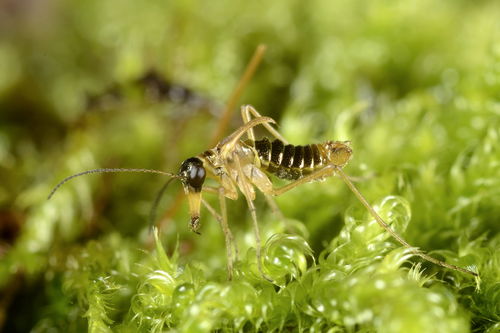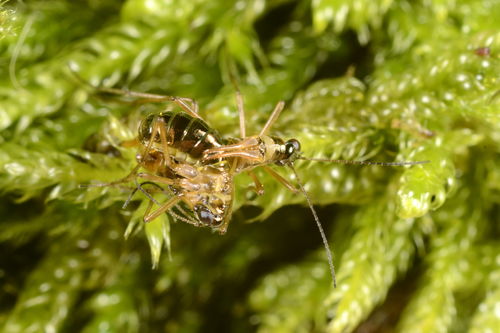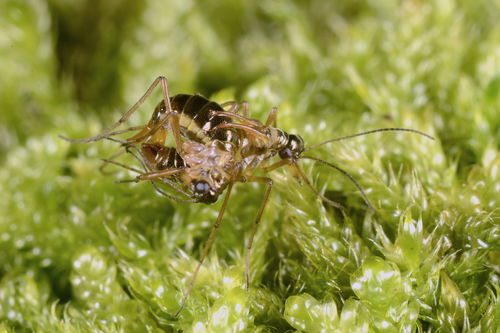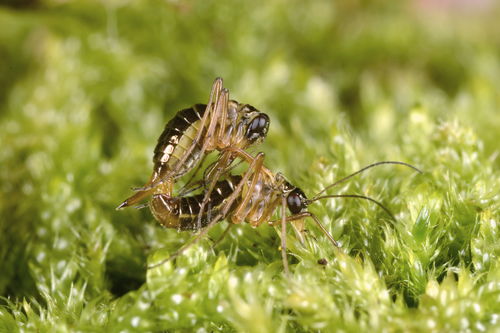Snow Flea, Boreus hyemalis (L., 1767 Mecoptera: Boreidae) found mating in Wyre Forest
John Bingham
All photographs copyright John Bingham
The Wyre Forest Study Group has been recording the distribution of Boreus hyemalis as part of the ongoing mapping of a number of interesting or key species found in the forest. Our results are now showing that the insect is quite widespread across the Wyre woodlands in suitable mossy habitat (Winnall 2009, Bingham 2012). Denise Bingham and I have found several new sites and starting to get a better understanding of the preferred habitat.
On November 12th 2013 we visited Withybed Woods looking for late season fungi, the weather was fine and sunny if a little cold, heavy rain had fallen during the night. Denise found the first Boreus hyemalis at the mossy base of a mature oak tree in a stream valley. This was our earliest record for the species and agrees with the November dates given by Withycombe in his paper on Boreus. (Withycome 1922).
As we then knew they were out we stopped to look on the steep bank above Dowles Brook on the Shropshire side of the forest at Chamberline Wood. This is an area of mature oak coppice with a bare but mossy ground layer, suitable habitat for Boreus. It was only a matter of minutes before we both started to find more, and then I noticed a pair in copulation. This was the first time we observed mating behaviour. We then found a male with a female locked on his back using the modified wing cases. I spent some time photographing this behaviour. Boreus hyemalis is flightless and the wings are reduced to buds in the female but the male has two spine-like outgrowths or claspers formed by the wing case that are used in courtship to hold the female (01). Withycombe's paper states that pairing takes place shortly after emergence which agrees with our observation as Boreus is more of a green colour when fresh and darkens to bronzy brown in a day or so. He mentions how the male carries the female on his back 'as in the case of the flea'.
Shorthouse (1979) also describes the mating behaviour of Boreus brumalis in some detail: “The male upon finding a female, springs and seizes her body with his modified wings. Once she is securely gripped, the male uses his hind legs and claspers to manoeuvre her into a position parallel to and above his body. He then releases his wings allowing the female to flex her rostrum between his coxae, fold her antennae between her legs, and stretch her legs posteroventrally. Once in this position the male then grips her fore-legs and rostrum with his wings. This position with the female above the male is maintained throughout copulation. The male usually runs about during copulation while the female remains motionless”.
The photographs show most of the behaviour as described by Shorthouse: the female with her body arched and antenna folded lying across the back of the male held by the claspers. Later they assume a more normal mating posture with the female on top with the male claspers holding on to her front legs, her antenna tucked under her body, and mid and hind legs tucked together. I searched the internet for images of this particular mating behaviour but found nothing showing the male spines or claspers actually holding the body of the female, although this behaviour is well documented (Buglife web links).
We have yet to discover larvae of Boreus but Shorthouse states that they form small chambers in compacted soil and aestivate throughout part of summer in these chambers. Descriptions of Boreus larvae and pupae are given by Withycombe (1922) as 6-7mm long when full grown, with a yellowish-brown head and white semi-transparent body that is curved like a weevil larvae. Looking deep in moss during spring and summer appears to be the best way to find them. Another challenge I guess. Pupation occurs in the chambers (Fraser, 1943) and the pupal stage lasts from 4 to 8 weeks. What they feed on seems to be debateable, moss or a soup of decomposed soil arthropods? I still think the adults are more detritivores on animal matter and not vegetarians but I may be wrong?
Finally a paper by Burrows (2011) describe in detail the ability to jump. The paper is quite extensive and informative, well worth reading, but in summary it states that both middle and hind legs work simultaneously (rather flea like) at considerable speed. The method involves a complex rotation of the trochantera and coxae powered by the depressor muscles. Acceleration was 6.6 metres per second covering a distance of 100mm, or 30 times the body length. When observing Boreus hyemalis I can certainly confirm they jump quicker than the eye can see and can cover 120mm in distance with ease. So once found you should not take you eye off them, as they can vanish with great ease!
On the day we discovered a total of 11 individuals on the slope but only covered a fraction of the bank, so many hundreds could have been present in the extensive mossy coppice stools. Typically moss that covered base of the trees rather than moss on the soil, or moss covered old oak coppice stools were the best areas to look.
With grateful thanks to Harry Green for providing the links to several of the key works relation to Boreus.
References and reading
Bingham, J. 2012. Snow Flea Boreus hyemalis (L., 1767 Mecoptera: Boreidae) in Wyre Forest. Worcestershire Record 32:13-14.
Whitehead, P F. 2010 Snow Flea in Worcestershire. Worcestershire Record 28:15.
Winnall, R. 2009. Snow Flea, Boreus hyemalis (L.,1767) (Mecoptera: Boreidae). Wyre Forest Study Group Review 2009. 10:42.
Buglife ; http://www.buglife.org.uk/discoverbugs/bugofthemonth/snowflea.
Buglife: http://www.buglife.org.uk/bugs-and-habitats/snow-flea
Burrows, M. 2011. Jumping mechanisms and performance of snow fleas (Mecoptera, Boreidae). Journal of Experimental Biology 214:2362-2374. The Company of Biologists Ltd.
Shorthouse, J. D. 1979. Observations on the Snow Scorpionfly Boreus brumalis Fitch (Boreidae;Mecoptera) in Sudbury, Ontario. Quaestiones Entomologicae 15:341-344
Withycombe, C. L. 1922. On the Life-history of Boreus hymalis L. Transactions of the Royal Entomological Society of London. 69. Issue 3-4, p. 312-319.
Images
01 Boreus hyemalis male showing claspers. John Bingham.
02 Boreus hyemalis pair. Male claspers holding female body. John Bingham.
03 Boreus hyemalis pair. Male claspers holding female body. John Bingham.
04 Boreus hyemalis paired. Female above. Male claspers holding her legs. John Bingham.



